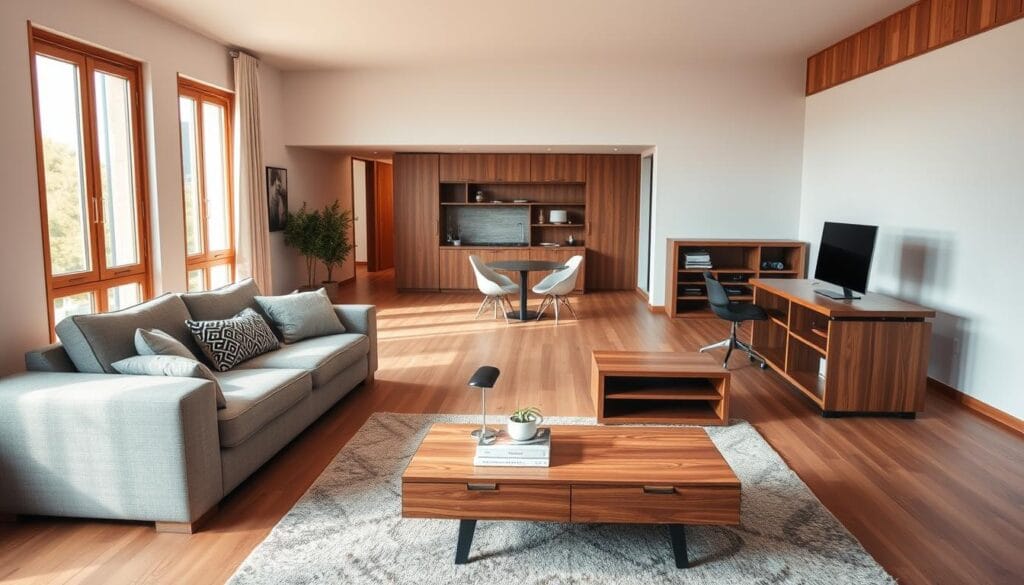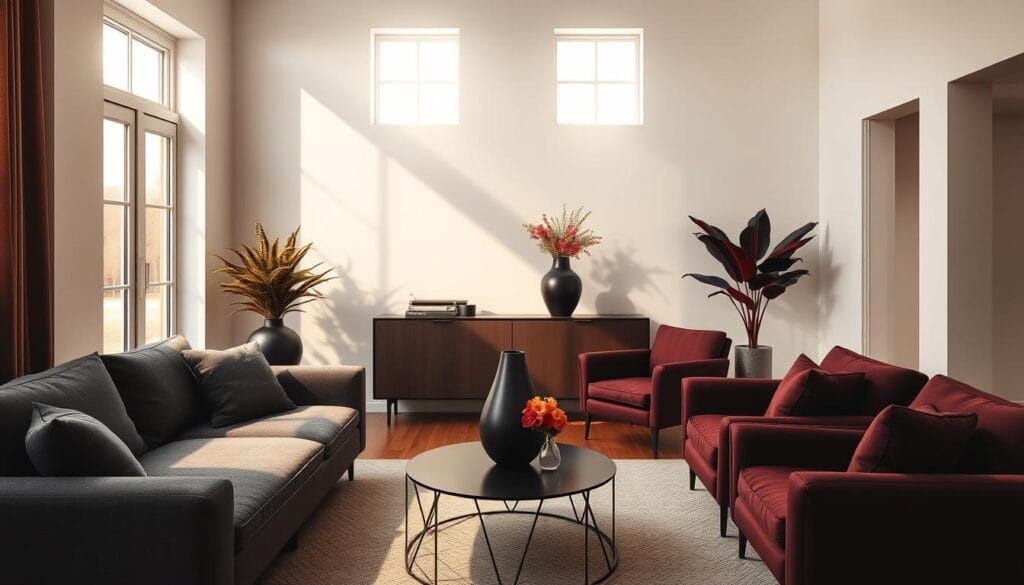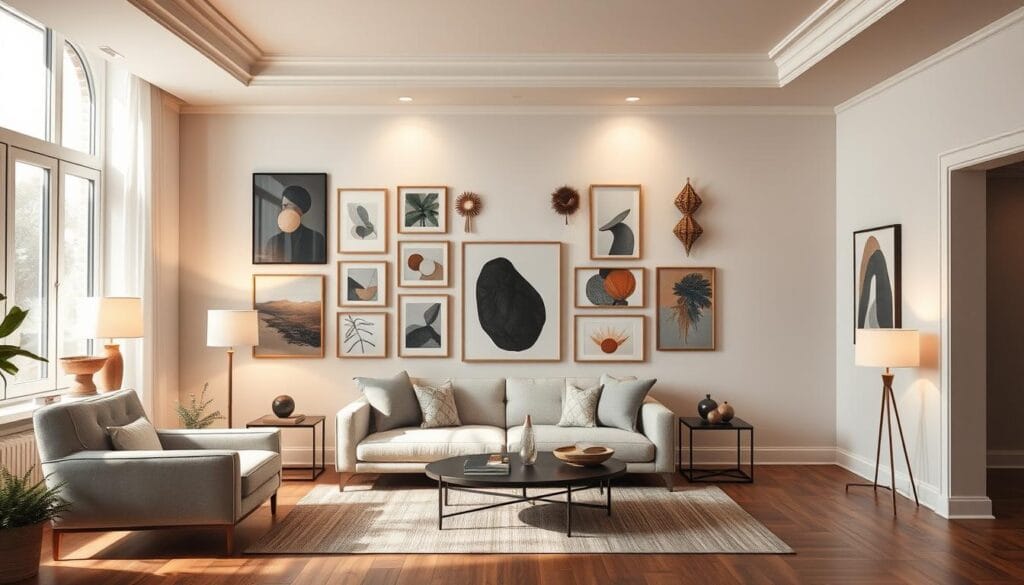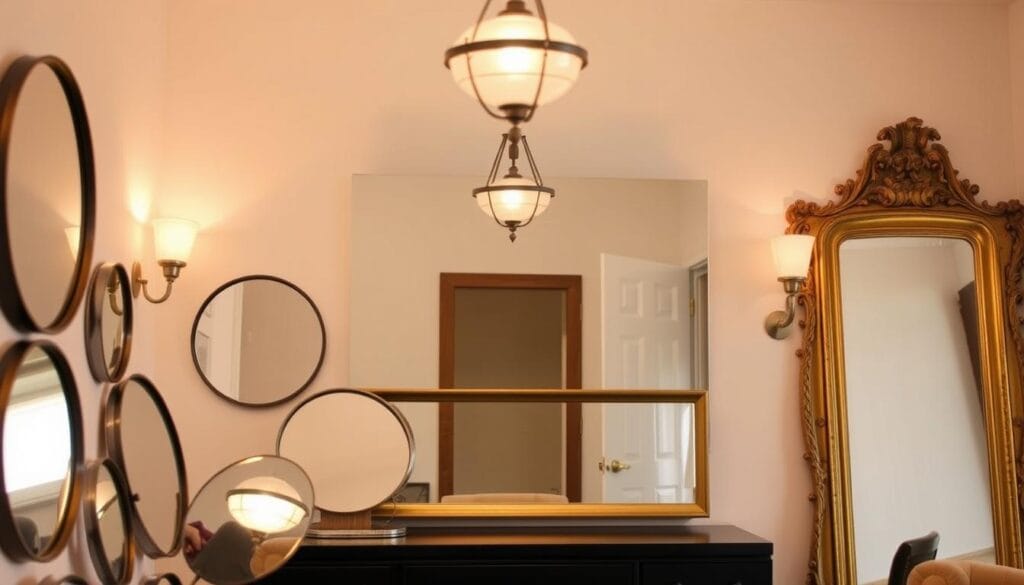One weekend, in a cozy Brooklyn bookstore, I found a design book. It showed how to make tiny spaces feel like paradise. The ideas were smart, using every inch without making it feel crowded.
About 60% of city dwellers want their small places to shine, without losing style or comfort. Changing how we see our small rooms can make them both useful and pretty. The trick? Use smart storage and furniture that has more than one use. Let’s explore how to make rooms feel bigger with good design!
Understanding the Basics of Small Space Design
A lot of people who live in cities have small living spaces. In fact, about 75% of them live in places that are under 1,000 square feet. Knowing how to design these small spaces is key. It helps make them both useful and beautiful without feeling too tight. Let’s look at the main things that can really make a difference.
The role of scale and proportion is very important in small space design. It’s vital to pick furniture that fits well to keep things balanced and not too crowded. For example, furniture that serves more than one purpose can make small spaces 30% more useful. Items like sofa beds, extendable tables, and storage ottomans are perfect. They save space and add value too.
The colors you choose can make a room feel bigger. Light colors, for example, can make spaces seem up to 20% larger than dark colors. Going for light shades like white, beige, or pastels helps make the room brighter. Mirrors can also make a room feel bigger by up to 25%. They show how important it is to use reflective surfaces in small designs.
Good lighting is crucial in designing small spaces, but it’s often forgotten. Natural light can make a space feel about 15% bigger. This shows how important it is to have good windows and light curtains. Also, using different types of lighting can change small rooms into places that feel larger and welcoming.
Finding new ways to use space up high, like with tall shelves and wall storage, helps free up the floor. About 60% of people living in small spaces look for storage solutions like this. It shows how important it is to keep things organized and clutter-free.
Choosing the Right Furniture
Choosing the right furniture is key for small spaces. Think about multi-functional pieces like storage ottomans and Murphy beds. These save space while adding value. It’s important to pick furniture that fits your room’s size. The right size enhances your space, while big pieces can make it feel tight.

Think up, not just around, when arranging furniture. Tall bookcases use vertical space well, making ceilings seem higher. Choose light-colored or leggy furniture to make spaces feel open. This way, your room will look and feel more spacious.
Putting furniture in the center can make a cozy spot for talks. This challenges the idea that open middle space looks bigger. Items like a versatile ottoman are great—they’re seats, tables, and more. Using light colors all around also helps the room feel bigger and brighter.
Using floating shelves and wall-mounted TVs can make more floor space. This makes rooms feel more open. Modular furniture can change with your needs, keeping spaces fresh. These efficient furniture choices help make any small area feel big and welcoming.
The Power of Color in Small Spaces

Choosing the right colors for a small space can change its entire vibe. Knowing how light vs. dark colors interact is crucial. Light colors, like soft blues, greens, and yellows, make a room feel bigger and more welcoming. They bounce light around, offering a breezy feel. Meanwhile, dark colors bring depth and elegance, ideal for feature walls that suggest depth without making the room feel tight.
Balance is key in small areas. Using different shades of the same color can make the room seem larger. This approach pulls everything together, making the space look wider and more in tune. Light neutrals such as white, cream, and taupe also help make a room feel open and light.
Accent walls can be a smart choice. They draw the eye and make the room’s size less obvious. Choose a contrasting color or a lighter tint of the main color for both unity and interest. About 70% of interior designers love using accent walls in small spaces because they really work.
Mixing your colors wisely with good design choices can boost the effect. Furniture that’s up on legs lets air and light move around, which helps a small space feel bigger. Plus, mirrors, which 80% of designers use in small areas, can double the light and visually expand the room.
Choosing colors isn’t just about the hue but also about creating a cohesive look. About 60% of homeowners choose a unified color scheme for peace and flow in their places. This shows how vital color harmony is, especially in tight spaces.
Thinking about light vs. dark colors in a practical way is smart. Light colors are best for a spacious feel, but dark colors are great for adding contrast without clutter. Avoid using too many bright or dark shades. Stick to two or three main colors along with light neutrals to keep things open.
Here’s a quick comparison:
| Aspect | Light Colors | Dark Colors |
|---|---|---|
| Space Perception | Creates openness and airiness | Adds depth and sophistication |
| Best Used For | Walls, ceilings, large furniture | Accent walls, small furnishings |
| Combining Options | Works well with light neutrals and pastels | Pairs with light colors and bold accents |
| Visual Effects | Expands visual space | Creates visual interest |
Colors have amazing power to reshape small spaces. Picking between light vs. dark colors depends on what you need and your room’s characteristics. Try out various shades, use accent walls, and ensure your colors match well. You’ve got the skills to make it stunning!
Smart Storage Solutions
Living in a small space requires smart storage methods. By exploring Creative Storage Ideas for Small Spaces, we can make the most out of our homes. A key approach is to use vertical space smartly. This may mean installing shelves from floor to ceiling. This trick not only saves floor room but also makes our spaces neater.
It’s also smart to use spaces we often overlook. Think about storage under furniture like beds with drawers or sofas with secret spots. These pieces serve two purposes, especially useful in tight places. Interior designers love these for their practical beauty.
We can also employ custom-made units to better use our space. Building in cabinets or storage into alcoves are great for keeping things while making the room look good. In a tiny New York apartment, tall cabinets made the living space better. And, a small studio in Paris showcased a bed with storage and a pop-out desk, making the room functional without losing style.
Sliding doors on cabinets help save space that regular doors use, perfect for compact areas. Having shelves that fold out gives us extra room when we need it without cluttering our space. These Creative Storage Ideas for Small Spaces not only reduce clutter but also make our homes feel bigger and more inviting.
For the best storage system, staying organized is key. Clearing out clutter and sorting items by type—like kitchen stuff, clothes, and books—makes a big difference. Getting advice from storage experts can give us custom tips for our homes. This way, we can use every bit of space we have. Let’s use these smart storage ways to make our homes both beautiful and orderly!
Incorporating Decorative Elements
Adding decorative pieces to small areas can change a room and make it more charming. It’s important to pick Artwork wisely. Choose art that adds to your room’s design without taking over. Pick pieces that match your room’s colors and vibe well.

Plants are a great way to make a small room feel lively. They add a fresh, natural touch. Whether it’s tiny herbs on your windowsill or a big fiddle-leaf fig, plants add color and texture.
Using textiles and patterns wisely is key in small spaces. Throws, cushions, and rugs add warmth and texture but don’t overdo it. Go for light fabrics and patterns like vertical stripes to make the room seem bigger.
| Decorative Element | Impact |
|---|---|
| Art | Enhances visual appeal without overwhelming |
| Plants | Introduces a natural, fresh ambiance |
| Textiles | Adds warmth and texture while maintaining minimal clutter |
| Patterns | Creates illusions of space through strategic design |
In small areas, choosing fewer decorative items can be better. By carefully selecting artwork and adding plants and textiles, you make your space welcoming. Every piece should add personality and coziness without crowding the room.
Utilizing Mirrors to Expand Perception
Mirrors do wonders in decorating small areas. They are more than just for checking your appearance; they can make spaces feel bigger. Let’s dive into which mirrors work best for tiny rooms and share tips for where to put them for the biggest effect.

Full-length mirrors work wonders in making narrow places look wider and more open. Place them to catch and spread light around, and your room will instantly feel more welcoming. This trick is perfect for dark areas, as mirrors can lessen shadows and make lighting more even.
Tall mirrors make the ceilings in a room seem higher, which is great for spaces with low ceilings. Putting mirrors on opposite walls also makes a room look endless, giving a spacious vibe.
Using mirrors on furniture, like cabinets or tables, is another smart move to brighten a room. But, it’s key not to use too many mirrors. Too many can make a place feel cluttered and overwhelming.
Putting mirrors across from windows can make a room up to 30% brighter by bouncing back natural light. A large mirror on a wall can be a central point, making the room look up to 50% bigger.
In narrow hallways, the right mirrors can add 25% more space by reflecting light and depth. Large mirrors in bathrooms can make them feel up to 40% bigger. Placing mirrors correctly can make a room brighter, cut down on shadows, and boost the feeling of space by up to 15%.
Mirrors help us make the most of every inch in small spaces. With these strategic touches, even the smallest spots can seem vast and welcoming.
For more inspiration on making the most of your space, check out these helpful tips.
The Role of Lighting in Small Spaces
Good lighting can make a small space feel bigger and more welcoming. A smart approach is layering different lighting sources. Combine ambient, task, and accent lighting for a well-lit and attractive area.

Natural light is key in small areas. Keep your windows clear and use light curtains or blinds. This lets in lots of natural light, making the space seem larger and more open.
Smart bulbs are amazing because they let you change brightness and color. With smart lights, you can control the light easily. This helps set different moods during the day.
Ceiling lights work great in small rooms since they use the space above. Go for flush mounts or recessed lights, especially if your ceiling is low. This helps the room look bigger.
Wall sconces and floor lamps are also great. Wall sconces save floor space and offer good lighting. Floor lamps light up dark corners and make the space feel more open. They also let you add a personal touch without taking up too much room.
LED strip lights can be placed under furniture or around the room for soft light. String lights also add a cozy atmosphere without making the space feel crowded.
Consider using mini chandeliers or pendant lights as main features. These don’t take up much space and look great. Picking designs that don’t block light or air flow is smart for maximum light.
By using different kinds of lights, your small space will not just look good but be more useful. It will also feel more open and charming! 🏡
Making the Most of Small Outdoor Areas
Transforming a small outdoor space like a patio or balcony can be both a challenge and a chance for creativity. With smart Patio and Balcony Styling Tips, tiny spaces can become beautiful and useful escapes.
Start with multipurpose furniture to maximize space. Foldable chairs and tables can boost your area by 25% when stored. Include compact seating to keep the area open and welcoming.
Container gardening is perfect for adding greenery to small spaces. By using vertical gardens, you save half the ground space. This lets you have herbs, flowers, or veggies. Arranging plants at different heights makes your space seem bigger.
Choosing the right flooring can make your small area feel larger. Different materials can define zones, making the space seem 30% bigger. This method adds beauty and organizes movement.
Effective lighting can make your outdoor area feel much cozier. Adding elements like hanging plants or canopies above can make it seem taller. For extra space, use walls for vertical gardens. This can give you 20% more space.
Add personal touches to make your outdoor area special. Use seasonal plants and various textures to enhance the mood. Choosing durable materials keeps your space welcoming all year.
By using these Patio and Balcony Styling Tips, you can create a beautiful outdoor spot, no matter its size.
Personalizing Your Small Space
Personalizing your small space means making it fit your style and using the space well. We want your home to show who you are and match how you live. By using smart furniture, adding your own touch, and planning a good layout, you can make any small space feel welcoming.
Start with the layout. A smart design helps your daily life run smoothly. Choose furniture that has more than one use, as 70% of homeowners do, to make the most of your space. Things like sofa beds or tables that fold save room and are stylish yet practical. Also, using space up high can give you 50% more storage, which is key in small areas.
Adding your own touch is very important in making a space feel like yours. A study found that 50% of people love their homes more when they add plants. We can take this idea and add things like unique ways to show off jewelry, which makes the space special and more fun.
Looking at advice from the pros at Jane Barnes Interiors, we see the value of keeping interiors light and bright. Light shades can make a room feel 20% bigger, giving off a welcoming and stylish vibe.
Our aim is to make your space both useful and uniquely yours without making it feel crowded. By choosing decor that suits your life, your home becomes more than just a place to live; it becomes a place you love. Let’s appreciate the unique charm of small spaces and make them truly reflect you!
Maintaining a Clutter-Free Environment
Keeping your small space free of clutter is crucial for a welcoming and useful home. Everyday organization habits are key. Doing simple things like putting items away right after use and sorting mail regularly can make a big impact. For example, having good paper management can cut down paper clutter by 60%. It’s the small steps that really add up! 📝
Seasonal cleaning tips are also important. Did you know rotating your seasonal clothes can make closets 30% more efficient? Using slimline hangers saves about 25% more space than regular ones, which is a huge deal. Also, going minimalist helps make your space feel open and airy. Choosing furniture that has more than one use can also improve storage by 40%, keeping things functional without feeling too crowded. 🧺
Using drawer dividers and shelves that hang on walls are clever ways to boost organization. Drawer dividers improve organization and access by 40%. Wall shelves can give you back 60% of your floor space. Thinking vertically helps, too! Vertical storage can add 50% more storage space in small rooms. With these smart choices, you can lessen clutter and make your living space calm and inspiring. 🌿
Don’t forget, cleaning out clutter regularly can cut down on clutter by about 50% if done every three months. So, let’s follow these tips to keep our spaces clutter-free. Your home is like a painting – let’s make it beautiful, functional, and free of stress! 🎨



